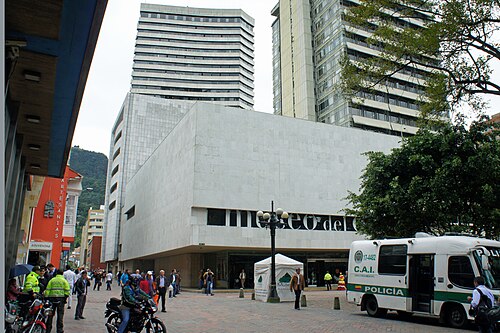This articleneeds additional citations forverification. Please helpimprove this article byadding citations to reliable sources. Unsourced material may be challenged and removed. Find sources: "Gold Museum, Bogotá" – news ·newspapers ·books ·scholar ·JSTOR(January 2014) (Learn how and when to remove this message) |
 | |
 View of the Museum of Gold | |
 Interactive fullscreen map | |
| Established | 22 December 1939 |
|---|---|
| Location | Carrera 6 # 15-82 (Parque Santander) Bogotá,  Colombia Colombia |
| Coordinates | 4°36′6.91″N74°4′19.20″W / 4.6019194°N 74.0720000°W /4.6019194; -74.0720000 |
| Director | María Alicia Uribe Villegas |
| Public transit access |  Museo del Oro Museo del Oro |
| Website | www |


TheMuseum of Gold (Spanish:Museo del Oro) is anarchaeology museum located inBogotá,Colombia. It is one of the most visited touristic highlights in the country.[1] The museum receives around 500,000 tourists per year.[2]
The museum displays a selection ofpre-Columbiangold and other metal alloys, such asTumbaga, and contains the largest collection of gold artifacts in the world in its exhibition rooms on the second and third floors. Together withpottery, stone,shell, wood and textile objects, these items, made of whatindigenous cultures considered to be a sacred metal, testify to the life and thought of the different societies which lived in present-day Colombia before theSpanish conquest of the Americas. Many indigenous groups did not consider gold to be a source of wealth, but rather held the belief it was charged with symbolic and religious values.[3] The Spaniards, for example, reported the Inca royal family claimed to be descendants of the sun and the moon, and that gold was the “sweat of the sun” and silver the “tears of the moon.”[4]
In 1934, theBank of the Republic began helping to protect thearchaeologicalpatrimony ofColombia.[citation needed] The object known asPoporo Quimbaya was the first one in a collection. It has been on exhibition for 70 years.[when?] The museum is today administered byBanrepcultural.[5]
The museum houses the famousMuisca golden raft found inPasca in 1969, that represents the ceremony of the newzipa (ruler) of Muyquytá, the basis for theEl Dorado myth. The heir to the chieftaincy assumed power with a great offering to the gods. In this representation he is seen standing at the centre of a raft, surrounded by the principal chieftains, all of them adorned withgold and feathers.
After a decade of work, the museum was expanded and renovated in October 2008. With the renovation, the museum organized the permanent exhibition in five rooms with archaeological objects and an interactive room. It also added an auditorium, some temporary exhibitions rooms, a cafe, a restaurant, and a souvenir store.
There are other locations of the Museo del Oro throughout Colombia, including in Calima, Quimbaya, Santa Marta, and Cartagena.[6]
The museum has a collection of 55,000 pieces, 6,000 of which are on display in their expanded building. There are bilingual descriptions of almost all exhibits. On the first floor houses the museum's main entrance, a shop, and a restaurant.
Exhibitions begin on the second floor. The main room is called "People and Gold in pre-HispanicColombia". In glass vitrines display goldsmiths' work from the different cultures which inhabited Colombia before the Spanish colonists arrived. The permanent exhibition is divided into different halls for every culture:Calima,Quimbaya,Muisca,Zenú,Tierradentro,San Agustín,Tolima,Tairona, and Urabá, and a special room called "AfterColumbus" (Después de Colón).
The exposition continues on the third floor, with "The Flying Chamanic" and "The Offering." The first shows the process of ashamanic ceremony with its different gold pieces, the second is divided into three parts: the "Offering Room", the "Offering Boat", and the "Lake".
At the end of the exposition, there is a "Profunditation Room" with artistic videos about the most important gold pieces of the museum.
On the fourth floor, the museum has an Exploratorium for the purpose of promoting interaction, participation and reflection around the diversity and meaning of the heritage preserved in the museum.[7]
Additionally, the Museo del Oro also allows research visits and has a “specialized advisory service,” through which researchers can access collections.
The museum has also engaged with internationally located museums in the past. In 2022, the Museo del Oro in Bogota loaned many works to Los Angeles County Museum of Art (LACMA) for an exhibition titled “The Portable Universe / El Universo en Tus Manos: Thought and Splendor of Indigenous Colombia.”[8] This exhibition comprised approximately 400 works, from figurative ceramics and ceremonial tools to textiles and metalworks.[9]
The cultural activity of Banco de la República extends as a network through 29 cities in the Colombian territory, and is carried out in the Gold Museum in Bogota, five Gold Museums in Armenia, Cali, Cartagena, Pasto and Santa Marta, the Ethnographic Museum in Leticia, the Luis Ángel Arango Library and the Casa Gómez Campuzano in Bogotá, the Library Network that extends through 28 Colombian cities, the Luis Ángel Arango Library Concert Hall, and Bogotá museums: Casa de Moneda, Botero Museum and, Miguel Urrutia Museum of Art (MAMU).
 Media related toMuseo del Oro, Bogotá at Wikimedia Commons
Media related toMuseo del Oro, Bogotá at Wikimedia Commons